Game: World of Warcraft: The Burning Crusade
Game Element: The Ring of Blood, 5-man quest chain
Discipline: Content Design
For today’s post mortem, let’s talk about outdoor quest chains and how to balance theme and mechanics.
So grab your gear and jump in to immerse yourself in a story of how I leaned heavily on fantasy to create visually stunning and thematically cohesive experiences.
It was a warm, sunny day in Irvine, when A.A. called me.
“Brazie!”, he called out with his usual pomp and swagger, “We have something delightful to craft today.
It will be memorable – to say the least, so I’ve conscripted the next week of your time from Scott.”
“What on earth have I gotten myself into I wondered….”
Little did I know it would be the be the first of five events that would charm and delight players throughout the years.
The Ring of Blood
For the uninitiated, the Ring of Blood is a dungeon-party (5 player) sized quest-chain that takes place in a single location in the outdoor (non-dungeon) world.
In between each step of the quest, the quixotic, yet poignant Gurgthok (Ion Hazzikostas, aka Watcher) and his assistant Wodin (Owen Landgren) test the mettle of the player and their team.
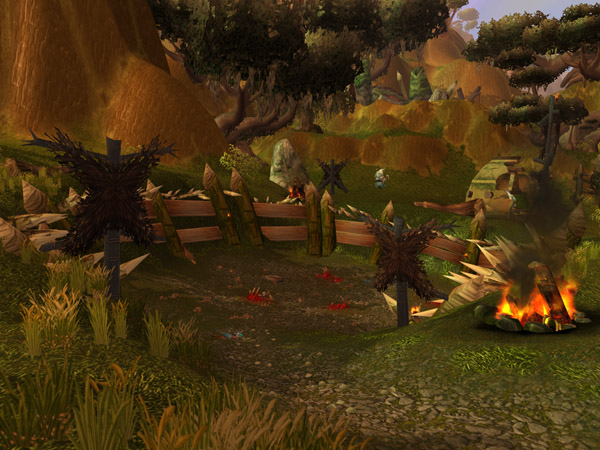
Lovingly crafted by A.A., the flavor text and theming of each wave was done to amuse, delight and challenge players.
Having the overall concept and creature theme defined ahead of time helps immensely – it set the flavor, pacing and sense of progression the game design needs to follow.
Brokentoe
Yes, Brokentoe. An unepic name for an unepic fight.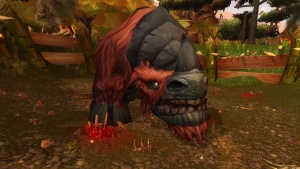
This encounter was initially part of a five-beast encounter that ended up feeling too similar to Nesingwary’s Expedition capper questlines.
However, the spirit of the idea was good, so he stuck around.
Brokentoe was designed to be a 3-person fight – something that you could get started while you waited for more people to arrive.
Each fight is supposed to be successively harder and more interesting than the previous one, so it’s wise to start on a (relatively) quiet note.
At this point in the game’s development, stuns had the secondary effect of causing monsters to ignore the stunned target.
So I put a very simple stun on Brokentoe to ensure he ran around the arena and scared the casters and healers a little bit.
But this fight was an easy one, intended to draw players in and invest them in finding more players to finish the challenge and create a social experience.
The Blue Brothers
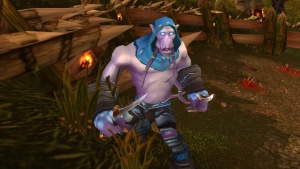
The Blue Brothers, a not-so-subtle reference to the classic 80s movie, were pretty simple.
Dual-wielding knives, they had Mutilate and Sinister Strike.
Pretty boring? Yes, but effective.
The Blue Brothers were CC immune – intended to ensure that by this point, your team of only-casters can’t just sheep and run around the arena to beat the encounter.
The fast-attacks and bursty damage were a simple way of saying, “don’t try to solo through this fight with heals.”
As a group, the presence of two monsters means your tank needs to be minimally capable of tab-selecting between the monsters to keep them from running away from him.
Almost like… practice… for dungeoning, perhaps? Nah.
Simple, effective and oh… yeah about 30% more HP and damage than Brokentoe.
Rokdar the Sundered Lord
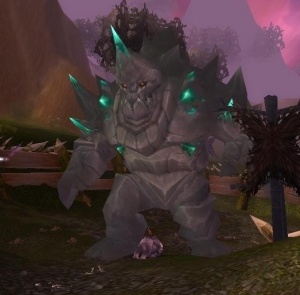 Ah, I loved this model. The Nagrand earth giants were one of my favorite creatures in the expansion.
Ah, I loved this model. The Nagrand earth giants were one of my favorite creatures in the expansion.
If you’ve been following the Blog series, the fracturing, shattering and creating smaller versions of themselves was a Family ability that Mike and I defined for the elite monsters when we first saw them.
Unfortunately, my ability to sell spawning visuals was not very developed at this point in my career and the best I could do was shrink the summoning creature.
A.A. was not impressed with it visually and told me to just make the fight Brokentoe 2.o – this time with more need for self-preservation.
So repeating the AoE stun, I also attached a DoT and a knock-away effect that took-advantage of the shape of the arena – players would be punted away from Rokdar, but never so far that they couldn’t just run back to the fight.
An additional 30% hp and 50% damage from the previous fight ensured he felt tough and also scared your tank a bit.
But I timed the knock-away effect to be around the same time that a tank would take mortal damage if he went the entire duration unhealed.
Think of it as an insurance policy to give the healer a few extra seconds to heal – and the tank time to dig through his bags for a potion.
Skra’gath
Skra’gath is another amazing model that came out of the game very late in Burning Crusade.
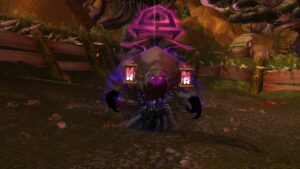
A wandering voidlord model, Skra’gath was created to begin hinting at the deeper story of the N’aaru, the void-kind and the story beyond Burning Crusade that is just now beginning to be written out in the story of Illidan in his book.
Yes, guys, this story line goes back that far.
Can you really believe that Metzen thought that far ahead?
Well, he’s been planning this next expansion for a very, very long time.
Skra’gath had an elemental adaptation mechanic.
The more the same school of magic was used against him the weaker it became.
This existed to help teach players some of the raid mechanics that were used in Blackwing Lair – to recognize and understand their schools of magic are important.
Further, he had an AoE Shriek – an effect that silenced any casters within melee range.
This was to teach the importance of keeping a distance.
Finally, piercing shadow existed to ensure that if you took too long to complete the fight (stacking healers) that eventually, your shadow resistance would go negative (a mechanic removed shortly after launch) and ensure you eventually die.
… Unfortunately, despite all of my careful planning, I swapped the class of the creature from “Paladin” to “Mage” thinking it would be cooler… and that resulted in the monster’s armor being reduced by 80%.
Causing him to be quickly shredded – and indeed easier than the fight before it.
The lesson?
All of your great design means nothing if you tune it below the level where players can appreciate it and are forced to pay attention.
The Warmaul Champion
 Ah, this guy. What a friendly clubbing arm he has! What delicious smiles and succulent metal plates. Ahem.
Ah, this guy. What a friendly clubbing arm he has! What delicious smiles and succulent metal plates. Ahem.
This guy was tuned at the difficulty of an actual Dungeon boss. And like any proper dungeon boss, he should scare the living daylights out of you.
So that’s what we set out to do.
Stacking him up with a set of typical warrior abilities, this guy hits hard, mortal strikes and charges at your team.
Very specifically, he charges at the *most distant* member of your team.
This mechanic was going to be used heavily in Karazhan and several dungeons, in an attempt to make Charge seem less random, so we included it on this fight, in hopes someone caught on and learned to exploit it.
The sundering cleave existed to threaten melee if they stood on top of the tank, instead of behind the monster and the battle shout and low-health enrage ensured the DPS of the monster would crush a tank if the didn’t bring either damage dealers or good healer.
… naturally this was the first of the fights to get nerfed after launch.
Outdoor questing groups are rarely composed properly of a 5-man party and even more rare that they are coordinated enough to handle this kind of intensity.
The idea for a dungeon tutorial was good… but a touch overdone.
Oops. The opposite problem from Skra’gath.
Mogor: The Final Challenge
So, after the champion, you’re done, right? No more questing, just time to grab your loot and… oh, wait, not quite yet.
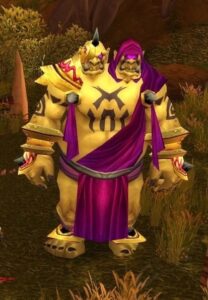
Adding an element of surprise, Mogor, one of the color commentating spectators in the ring, heads into the ring to protest your supremacy.
Talk about hands-on management!
The Mogor fight was designed to highlight several class-specific mechanics relevant to dungeoneering:
- Flame shock introduced a dispellable effect which eased the fight if handled
- Healing wave introduced an interruptable effect which shortened the fight if stopped
- Ice totem introduced an additional target, which dealt pulsing AoE damage and reinforced target swapping
- Revive-self introduced the idea of unpredictability and multiple phases, keeping players alert
- Frenzy introduced the idea of enrage phases – increasing damage on the tank by 300% rewarded saving and using defensive and damage boosting cooldowns for the second half of the fight.
Finally, all of these mechanics fit within the thematic image of an Ogre shaman.
How many of these did you catch when you played the fight? Maybe you just zerg rushed it down with 20 people waiting to do the quest.
That’s OK too.
Working together with other players is one of the fundamental features that made WoW such an appealing experience.
But Blizzard quality and polish are all about thinking through each moment and giving the opportunity for a lesson, even if most never see or actively notice it.
The Rewards
Did you think we were done just because we finished up with the monsters? No sir!
It’s not enough to just create an interesting, difficult and engaging story sequence in the game.
There needs to be a pay-off for investing the time, effort and organizational energy required to complete a multi-person questline.
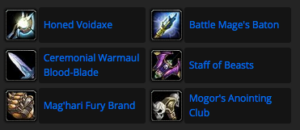
And after some lobbying, Travis Day, aka Indalamar of the Legendary Warrior youtube video, finally conceded to make some awesome items for the end of this questline.
But not before coming into my office and making me PROMISE. Promise. SO. HARD. that the questline monsters would be tuned tough and worthy of the effort.
I’m not exactly sure if he felt it was tuned hard enough, but in the end, the rewards he made were fantastic, memorable and well-worth the effort of organizing a group to do this questline.
And that’s why the Ring of Blood was worth a full blog-post of its own.
It understood the niche it wanted to fill, gave the players a reason to care, gave them ways to improve if they wiped on a fight, made them feel good when it was finished and perfectly suited the fantasy of jumping into a pit full of bloodthirsty fighters.
Lessons
When I was designing these quests, it was crucial to ensure that the fights aligned with the overarching theme without overwhelming players with excessive complexity.
By striking the right balance, the fights become not only mechanically engaging but also visually appealing, leaving a lasting impression on the players.
Leaning hard into the theme can make players laugh and smile as it resonates with them.
The key lesson here is that a well-executed visual theme can elevate the overall quest chain, making it more enjoyable and memorable for players, even when the fights themselves were not supposed to be overly intricate.
It is a testament to the power of storytelling and creating moments that evoke emotions, proving that sometimes, simplicity with a strong theme can bring about the most rewarding experiences.
Fantasy at its finest.
I hope you enjoyed this post! Please share it with your friends, and they deserve to appreciate the time and love that goes into every game they enjoy.













2 Responses
I used to have a routine when I would quest through a zone in WoW. Smash through all the solo content quests in an efficient manor, and if there were any group quests, I would pile them all in my quest log and spend the last few hours in a zone shouting to the sky for help. Surely there would be someone in the same situation who also wanted the higher quest exp and blue item upgrades usually given. I felt like the Ring of Blood really changed that habit for me, the fights were as difficult as some dungeon bosses. We’re talking Burning Crusade bosses too, and laid out back to back in rapid succession. I also found a huge collection of players would hang out in the ring and help others through content even if they were not getting credit for the quest. It was that fun of an engagement, and that difficult for your standard player.
So very true. It was a social anchor point – something harder to find in a world of solo questing. I believe they made the outdoor island challenges to re-encourage this type of behaviour.